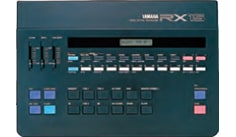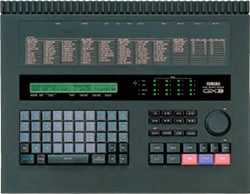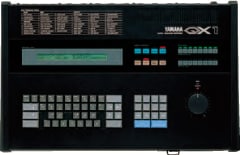RX and QX—Invaluable to both live performer and home producer
- Home
- 40th Anniversary Model
- History
- Chronology
- Product Lineup
- News
- Artist Comments
RX and QX—Invaluable to both live performer and home producer
The RX11 owner's manual features a detailed explanation of PCM. At right is a section quoting numerical formulas to prove sampling theories, information you would never find in a modern owner's manual.
Together with the synthesizers of the Yamaha DX Series, our RX Series rhythm machines and QX Series MIDI sequencers played a major role in defining the sound of the eighties. Before the RX Series arrived on the scene, the majority of drum machines had analog synth tone generators at their core, but in stark contrast, this Yamaha series came to the forefront with sounds based entirely on PCM—or in other words, sampling. And whereas drum machines had typically been used to generate the robotic grooves of techno and other similar musical genres, the authentic drum sounds of the RX Series as well as its support for programming of volume changes, which were called "accent levels," now made it possible to produce highly realistic rhythm patterns. The PCM drums of the RX Series rhythm machines were the perfect foil for other instrument sounds produced using FM, and these devices thus became a driver of the enduring popularity of our FM-only DX synths. What's more, they came equipped with large drum pads that keyboardists could conveniently use on-stage to play percussion parts. The cowbell in particular had a very distinctive sound and was used in a great many songs of the day.

RX11

The RX21, which was capable of receiving MIDI velocity commands

RX15

The powerful QX3, which played an active role in many live performances. The QX3 sold for 158,000 yen.
With the exception of headphones, pedals, and other similar peripherals, it was very rare for a musical instrument producer to market products that did not produce sounds of their own, yet six months after introducing the RX Series, we released just such a device in the QX-1 MIDI Sequencer. With its extremely fine resolution of 384 ticks per quarter note, eight tracks, memory capacity for up to 80,000 notes, and eight MIDI output terminals, the QX-1 attracted much attention as a full-fledged professional MIDI sequencer suitable for either recording or live performance. Released in 1986, the QX-5 cost less than 70,000 yen, putting it within the reach of amateur musicians and helping to boost the popularity of home recording. Home producers were already using computers and MIDI sequencing software by the latter half of the eighties, but the supply of power in live music environments was not always reliable. The hardware sequencer could be used with confidence in this type of situation, an advantage that helped to make the QX Series a long-time favorite of the pros.

QX1

QX5







